The Honey Gourami is an extremely popular freshwater fish. Although it may not be as popular as the Dwarf Gourami’s, it still is popular. The primary factor that might have influenced the popularity of other Gourami over the Honey Gourami is that they may appear slightly plain in a retail setting. A well-cared-for Honey Gourami, however, will exhibit stunning colors that are absolutely bedazzling. Its beautiful appearance and the fact that it can be cared for by aquarists of all experience levels make it an ideal fish to adopt. They are also very hardy fish that can survive a wide range of conditions. Moreover, these fish exhibit a peaceful temperament, making them compatible tank mates for multiple fish.
This article will run through everything you need to know about this cute and fun freshwater fish.
| Information Chart: | Ember Tetra |
| Scientific Name | Trichogaster Chuna |
| Family | Gourami Family |
| Care Level | Very Easy |
| Temperament | Very Peaceful |
| Colour | Females are silvery grey while the males are honey–orange and black |
| Lifespan | The average lifespan ranges from four to eight years |
| Size | Adults usually are between 1.5 to 2 inches long |
| Diet | Omnivorous Diet |
| Minimum Tank Size | At least 10 gallons |
| Temperature | Between 71 and 82 degrees Fahrenheit (22 to 28 degrees Centigrade) |
| Water conditions | pH level should ideally be acidic and hard with a pH ranging from 6.0 to 7.5 |
| Tank Mate Compatibility | Compatible with more of the same species or other peaceful, small fish |
| Preferred Tank Set-Up | Freshwater tank with lots of plants with multiple hiding spaces |
| Sexual Dimorphism | Adult females are larger than the males while also exhibiting a brownish color. Females also have a mid-lateral stripe that extends from behind their eye to the caudal peduncle. Males also show a similar stripe but have a different body color. Their body color is slightly orange-ish with yellow margins on their anal and dorsal fins. |
| Lighting | Moderate Lighting |
Table of Contents
Honey Gourami: A Quick Overview
Honey Gourami, also known as Trichogaster chuna, is a small, peaceful fish native to Southeast Asia. It is popular in the aquarium trade due to its attractive golden color and easy care requirements.
Honey Gourami are omnivorous and will accept a variety of foods, including flakes, pellets, and live or frozen options. They thrive in a well-planted tank with a moderate current and prefer a pH range of 6.0-7.5.
Appearance of Honey Gourami

Honey Gourami Appearance :
The Honey Gourami has an orange-colored body and can grow to a maximum length of seven centimeters. Just like with many other species of Gourami, the males exhibit brighter colors than the females. The males have a light orange color all over their bodies except for the throat and fins. A combination of blue and silver covers the area on their throat. This extends from the base of their head to their belly. Unlike the males, adult females have a silver body with a light grey color observed on their fins. Coincidentally, this is the color that males have at birth, but they develop their signature orange as they grow.
When the females are ready to breed or are in spawning condition, the color on their bodies may appear to be amplified and even brighter. This serves as a signal to the males that the females are ready to breed. The males will also have their undersides becoming somewhat darker during times of breeding.
The females’ dorsal and anal fin ends appear rounded in shape, while in the males, they seem sharpened. The males of the fish are thinner compared to the females, who are a little larger. A close look at the fish will let you see a unique dark brown stripe that starts close to the eye and marks the body.
The lifespan of a Honey Gourami :
The typical Lifespan of a Honey Gourami is between 4 to 8 years.
In an ideal environment with good conditions that favor the fish, the Honey Gourami will thrive and live up to eight years.
Honey Gourami Size :
The typical Honey Gourami grows up to one and a half inches on the lower end and two inches for specimens that are slightly larger.
The Honey Gourami is not a very big fish. Although the adult honey gourami typically grows up to between 1.5 to 2 inches, there have been cases where Honey Gourami have grown up to almost 3 inches long.
Natural Habitat and Origin :
The fish lives in freshwater and is native to India (north-eastern parts) and Bangladesh. The Honey Gourami has also been spotted in Nepal and other parts of southeast Asia. The fish is mainly found in slow-moving rivers, lakes, and stagnant ponds, where it dwells in areas of thick vegetation but of softer waters. In the wild, the fish is commonly found in the upper and middle levels of the water. The Honey Gourami has adapted to a kind of hardy life because most of the time, its habitat stands to be ravaged by droughts and floods. However, it still manages to survive. It is indeed a tough fish that can survive in a wide variety of water conditions, provided it has access to adequate food.
The Honey Gourami typically dwells in the upper or the middle part of the water it inhabits. It uses the dense vegetation that is naturally present in its natural habitat as hiding places. It is also known to have used this vegetation as a source of food. In low altitude places, the fish tends to spread out and is often affected by seasonal variation due to the monsoon rains in June to October.
Honey Gourami Care and Tank Set-Up :
Honey Gourami Tank Size and Specifications :
Optimum Tank Size for Honey Gourami :
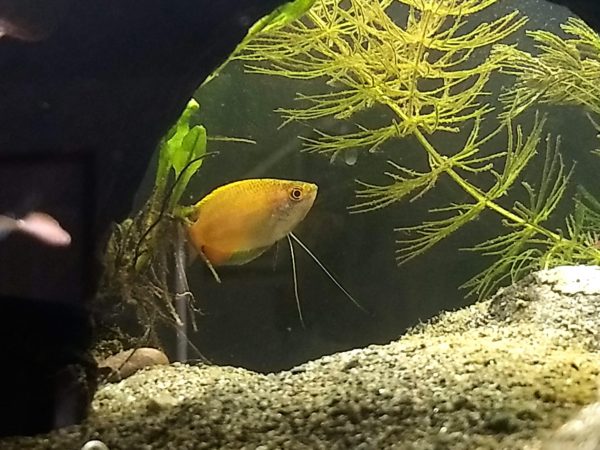
The recommended tank size for Honey Gourami is 20 inches long, 10 inches wide, and 12 inches tall.
The ideal tank size for the Honey Gourami is a minimum of 10 gallons, assuming you won’t be keeping more than 1. The rule of thumb is 10 gallons for one, 20 gallons for 2, and then 5 gallons more for each additional fish after that. They do require a bit of space, but they are still relatively easy to care for, making them popular among aquarists of all experience levels.
Filter Type :
We recommend a sponge filter or a low-power internal filter for a tank that houses Honey Gourami. This helps keep the water moving rather than stay stagnant. It also helps prevent the occurrence of dark spots in the tank. Although some owners keep them in planted tanks without filters, we do not recommend this.
Substrate :
Finely ground substrate is a suitable option for Honey Gourami. Sand or gravel would be an ideal substrate for them. Make sure that the substrate is cleaned before being placed inside the tank. If it is not clean, it could potentially make the water in the aquarium cloudy.
How many Honey Gourami in a 10 Gallon Tank?
A ten-gallon tank can hold one Honey Gourami. The general rule of thumb that is followed when it comes to housing Honey Gourami is 10 gallons for one, 20 gallons for two, and an additional 5 gallons for each fish added after that.
Water Parameters for Honey Gourami :
Water Temperature :
The ideal water temperature for Honey Gourami is Between 71 and 82 degrees Fahrenheit (22 to 28 degrees Centigrade).
The Honey Gourami is a very hardy fish. It can endure a wide range of conditions. The Honey Gourami can withstand slight changes to the water parameters even if they do not suit it. This is not recommended, however. The fish thrives in ideal water conditions and will exhibit brighter colors when in an environment better suited to it.
Water Flow Rate :
The Honey Gourami is a fish that does not require a high water flow rate, but we recommend that water not stay stagnant in the tank. A low-power filtration system with a sponge filter to the tank can accomplish this.
pH Level :
The perfect water pH level for the Honey Gourami is acidic and hard, with a pH ranging from 6.0 to 7.5.
As you can tell from the pH range that the Honey Gourami can live in, it is a very hardy fish. It can even survive in conditions that skew slightly from these parameters. We do not recommend this, though. Stick to a pH between 6.0 and 7.5 for the best health of your fish.
Water Hardness :
The recommended hardness of the water for Honey Gourami is between 6 and 13 dGH. Also, the pH is to be kept slightly lower.
Honey Gourami Tank Landscape :
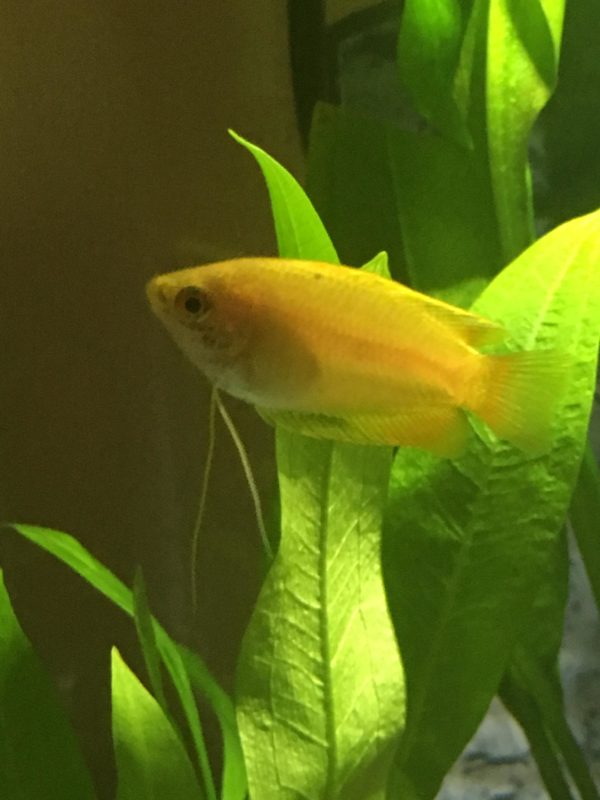
The Honey Gourami is a hardy freshwater fish that is easy to keep in the aquarium thanks to the harsh habitat it has endured in the wild. This is not to say that you don’t have to take good care of it when keeping it in the aquarium. Their habitat is filled with dense foliage and plant matter like sticks, fallen logs, aquatic plants, and leaf litter in the wild. This is why a lot of vegetation like floating plants, driftwood, and other vegetation would help recreate the natural habitat.
Best Plants for Honey Gourami Tanks :
An absolute must for Honey Gourami Tanks is a lot of plants and vegetation. They are fish that like spending most of their time near the top of the tank, close to the surface. Ideal plants for their tank would be plants that are bushy and tall. A couple of plants that are no brainers would be the water wisteria and hornwort. These can be planted in many ways and will go a long way in keeping your fish happy. Other plants you can include in the tank for the Honey Gourami are :
- Cryptocoryne wendtii
- Amazon Sword
- Vallisneria
- Ludwigia Repens
- Water Lettuce
- Amazon Frogbit
- Java Fern
- Salvinia
Decorations for Honey Gourami Tanks :
The right way to decorate the tank for any fish is to try and recreate its natural habitat. For the Honey Gourami, in particular, this would include having heavy vegetation in the tank. This also serves as a hiding spot for the fish. They typically do perfectly fine without any décor in the tank. Just a few natural-looking twisted roots, stones, and some driftwood are more than enough. The Honey Gourami typically spends most of its time in a specific tank spot, a lot like a floating leaf. The substrate isn’t a compulsory addition to the tank, but keeping the plants in the tank is highly recommended. The substrate also helps maintain the pH of the water.
Lighting for Honey Gourami Tanks :
Honey Gourami typically live in shallow waters. This means that their natural habitat is pretty bright. However, the Honey Gourami is not exposed to it all, as the water is usually covered by dense vegetation. This means they don’t need a lot of special lighting. The regular LED lighting unit is more than sufficient to keep the fish and the plants that surround them healthy.
Nitrogen and other Nutrient Requirements for a Honey Gourami Fish Tank :
The concentration of ammonia and nitrites in the water sees a sharp increase when fish in the tank produce waste. This accumulation of chemicals in your tank is hazardous to the fish. These chemicals need to be neutralized to maintain water quality in your tank and keep it in a hospitable environment. On average, the nitrogen cycle can take anywhere from 2 weeks to 2 months to be completed in the tank. Once the waste decomposes, the ammonia levels increase until they peak and then start to decline. Now, the nitrate oxidizes the ammonia and leads to the formation of nitrite.
Feeding Honey Gourami :
Best Diet for Honey Gourami :
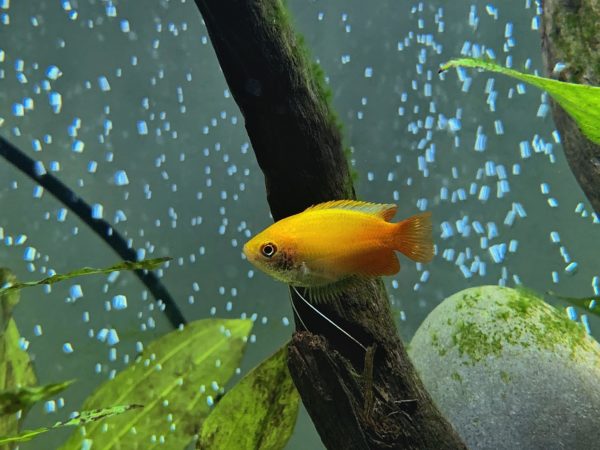
Honey Gourami are omnivorous fish. That means they feed on small insects and plant parts that they come across in the wild. Feeding the honey Gourami in the tank is relatively easy because it will feed on live, frozen, and artificial food. You can also provide flakes to them, and they will gladly eat. The other live foods that you can give the fish include blood worms, brine shrimp, and Corethra. Make sure they have a balanced diet that contains both food pellets/flakes and live/frozen food. Also, too much-frozen food and live food is not advisable. This should be given to them occasionally as a treat.
To help keep the tank clean and hygienic for the fish, ensure that you clear any food particles that the fish leave after a meal. If left in the tank for long, such food particles may act like bacteria brooding havens.
How often should you feed Honey Gourami?
Honey Gourami should typically be fed only once or twice a day.
Do not make the mistake of overfeeding your Honey Gourami. You should follow the rule of thumb while feeding them to make sure you do not give them more food than what the fish can consume in 2 to 3 minutes.
Honey Gourami Behaviour and Temperament :
Are Honey Gourami lone or societal in nature?
Honey Gourami are social fish that should ideally be kept in schools or at least in pairs. However, they have shy personalities as individual fish. This means that if they’re left alone, they will become even more timider than they already are and will spend most of their time hiding away behind plants and rocks.
Honey Gourami Ideal Tank Mates :
Ideal Tank Mates for Honey Gourami :
Honey Gourami are very peaceful fish that are compatible with quite a few other species too. Some of them are :
- Mollies
- Elephant Nose Fish
- Platys
- Swordtails
- Corydoras Catfish
- Rasboras
- Loaches
Bad Tank Mates for Honey Gourami :
Some species of fish are not suitable to keep as tankmates for Honey Gourami. Fish that are aggressive, large, or even semi-aggressive fish that could bully them are bad options as tank mates for the gourami. In addition to this, some tetras can also be a little aggressive, making them lousy tank mates.
Breeding :
Breeding the Honey Gourami is not complex because you can easily distinguish the male from the female. The males usually have brighter coloration with a deep blue abdomen. The female, for her part, is slightly larger than the male but with a paler color.
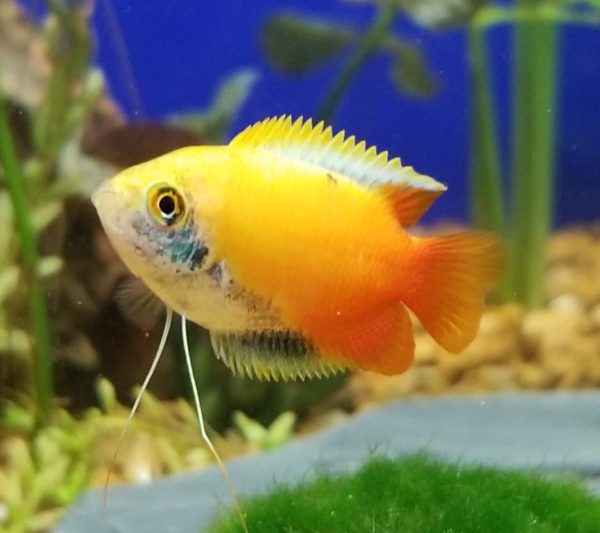
In the wild, the fish will make their nests on the foam just near the water’s surface. The male usually builds the nest from the bubbles on the water when spawning is just about to occur. In a bizarre dance show, you will see the male dancing and swinging just near the female. Once the eggs have been laid and fertilized during a spawning session, the male will take care of them. Therefore, you should remove the female once spawning is finished because the male will take the eggs until they hatch.
Honey Gourami Breeding Level – Easy
Honey Gourami Sexual Dimorphism :
The first difference that can help us distinguish between adult male and female Honey Gourami is their color and size. Females are noticeably larger than males and are brownish. They also have a broad stripe across their body that extends from behind their eye to the caudal fin. Males have a similar stripe, but their body color is a brighter orange than the brown of the females. The fins on the males also have a yellowish portion.
Honey Gourami Common Diseases and Treatment :
Fungal Infections :
If your fish has fluffy white growth along the length of its body, head, or even mouth, it is safe to say that your fish has a fungal infection. The safest route to proceed would be first to quarantine the infected fish. Then, use over-the-counter medication like antifungal medicine to treat your fish. Once the fish has been treated, let it stay quarantined for a week or so before you go ahead and reintroduce it to the original tank.
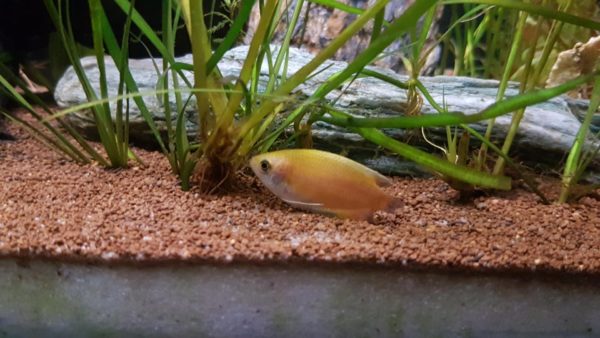
Ich (White Spot Disease) :
One of the most common diseases in fish is the white spot disease, also known as Ich. An aquatic protozoan parasite causes it. You can diagnose this disease if you observe a lot of small white spots on their fins, bodies, and even gill covers. Fish with Ich can also be seen crashing against the substrate or other objects, including the plants, glass, and other solid things in the aquarium. The best way to treat Ich would be to first raise the temperature of the water in the tank to 82 degrees Fahrenheit for three days. Following this, the usage of over-the-counter medication for Ich is recommended.
Bacterial Infections :
This is another common infection that can be seen in Honey Gourami. Fish are diagnosed with a bacterial infection if they have bloody fins or sores and ulcers on the body and head. The only recommended treatment would be to treat the tank with over-the-counter antibacterial medication.
Flukes :
External fish parasites are often referred to as flukes. When they cause infections in fish, it is visible to the naked eye. You can generally find them stuck on to the gills of the fish or the skin. The recommended treatment would be to treat the tank with over-the-counter antiparasitic medicine.
Facts about the Honey Gourami :
- Initially, the male and the female honey gourami were identified as two separate species.
- It is the responsibility of the male honey gourami to look after the nest and the fry
- There is a difference in color between the Honey Gourami found in the wild as opposed to the ones found in aquariums.
- Honey Gourami are often mistaken for Dwarf Gourami.
- Although Plants almost always surround honey Gourami, they do not always have plants in their nests
Are Honey Gourami right for you?
Whether you are a seasoned or first-time fish keeper, Honey Gourami is a good choice. They are compatible with other fish species and are low maintenance. All you need to do is re-create their natural habitat, and once they acclimate to their new home, you have a fish you can care for, for a very long time.
FAQ :
How difficult is it to breed Honey Gourami?
It is quite easy to breed honey gourami. Even first-time aquarists can breed them.
How many times a day should I feed my Honey Gourami?
Honey Gourami should not be fed more than twice a day. Feeding them once or twice a day is sufficient. Also, keep in mind that overfeeding them is a bad idea. Do not give them more food than what can be consumed in 2 to 3 minutes.
What plants should I keep in the tank for my Honey Gourami?
Some plants that can be kept in the tank of Honey Gourami are Cryptocoryne Wendtii, Amazon Sword, Vallisneria, Ludwigia Repens, Water Lettuce, Amazon Frogbit, Java Fern, Salvinia, hornwort, and water wisteria.
Does the Honey Gourami eat algae?
Honey Gourami are omnivorous fish that require both algae and fish food in their diet. They do eat algae to balance out their diet.
Conclusion :
Honey Gourami is not a favorite just for us, but for a lot of people out there. We also think it will be a perfect fit for you, regardless of your experience in keeping fish. They are an ideal addition to any aquarium and will not disappoint. We wish you all the best of luck in your journey of keeping and caring for Honey Gourami!
No related posts.
